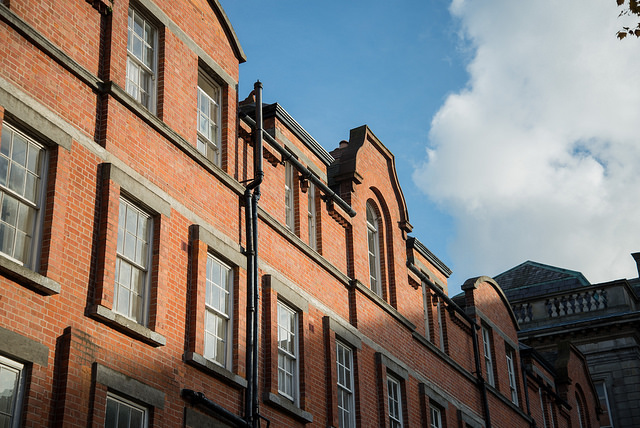
In June of this year, the College and the wider community mourned the loss of our beloved maple trees, which had stood the test of time for over 175 years. A much older testament to the longevity of the university, however, occupies pride of place at to the end of Library Square, namely the red-brick range known as the Rubrics. In spite of the circumstances, the oldest building on campus is now afforded unimpeded visibility from the Campanile eastward, and some of its history deserves to be revisited.
Construction began around the year 1700 when the Rubrics was conceived as completing part of a quadrangle designed to close off the planned Parliament, or Front, Square from what is now known as Library Square. As a result, the red-brick east range was built and purposed as a permanent student residence alongside an almost identical northern range adjoining it. The sister of the Rubrics, called Rotten Row for reasons unknown, was added in the 1720s but was later demolished for the site of the Graduates Memorial Building (GMB) of 1902 in commemoration of the university’s tricentenary.
Throughout its long history spanning over three centuries, the Rubrics has been subject to many alterations: in the 1840s, three bays were removed from each end of the range to provide access to what is now New Square. Later alterations took place under Robert John Stirling in 1894, who refaced the Rubrics’s orange-coloured brickwork and added the curvilinear gables that nowadays give the building its distinctively Dutch character. Over the past few years, the Rubrics has been faced with ongoing renovations, which have come under scrutiny as Dublin’s housing crisis reaches a boiling point.
As the oldest standing building on campus, the Rubrics has been in near-constant use since its foundation as a residential hall in the early 18th century and, therefore, has its fair share of history in its walls. As part of routine excavations for heating pipes between 2001 and 2002, the team uncovered human remains over the original site of the College’s predecessor, the All Hallows’ monastery – the monastery’s cemetery once occupied the area around Library Square.
The most infamous skeleton of all associated with the Rubric’s long history, however, is the story of Edward Ford’s death – a sinister turn of events that has been subsumed into the makings of a popular legend around campus. The basic account of the night of March 7th, 1734, runs that Ford, elected as a Fellow, had the windows of his room broken at the hands of a rowdy group of students disguised in white. In retaliation, Ford drew his pistol and fired into the crowd. The group dispersed and, momentarily, returned with their own arms, fatally wounding Ford from his window in House 25 of the Rubrics. Four undergraduate students were placed on trial but were later acquitted due to the lack of witness testimony. As part of the enduring legacy of Ford’s murder in the College imagination, it is reported that his ghost wanders about his old residence clad in Georgian attire and a powdered wig.
As the oldest standing building on campus, the Rubrics will no doubt inspire more intrigue and stories in the future.






